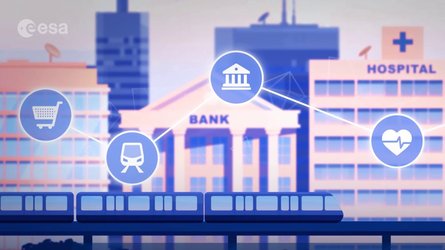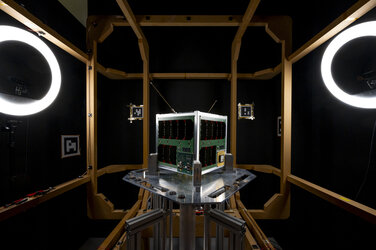Accept all cookies Accept only essential cookies See our Cookie Notice

About ESA
The European Space Agency (ESA) is Europe’s gateway to space. Its mission is to shape the development of Europe’s space capability and ensure that investment in space continues to deliver benefits to the citizens of Europe and the world.
Highlights
ESA - United space in Europe
This is ESA ESA facts Member States & Cooperating States Funding Director General Top management For Member State Delegations European vision European Space Policy ESA & EU Responsibility & Sustainability Annual Report Calendar of meetings Corporate newsEstablishments & sites
ESA Headquarters ESA ESTEC ESA ESOC ESA ESRIN ESA EAC ESA ESAC Europe's Spaceport ESA ESEC ESA ECSAT Brussels Office Washington OfficeWorking with ESA
Business with ESA ESA Commercialisation Gateway Law at ESA Careers Cyber resilience at ESA IT at ESA Newsroom Partnerships Merchandising Licence Education Open Space Innovation Platform Integrity and Reporting Administrative Tribunal Health and SafetyMore about ESA
History ESA Historical Archives Exhibitions Publications Art & Culture ESA Merchandise Kids Diversity ESA Brand Centre ESA ChampionsLatest
Space in Member States
Find out more about space activities in our 23 Member States, and understand how ESA works together with their national agencies, institutions and organisations.
Science & Exploration
Exploring our Solar System and unlocking the secrets of the Universe
Go to topicAstronauts
Missions
Juice Euclid Webb Solar Orbiter BepiColombo Gaia ExoMars Cheops Exoplanet missions More missionsActivities
International Space Station Orion service module Gateway Concordia Caves & Pangaea BenefitsLatest
Space Safety
Protecting life and infrastructure on Earth and in orbit
Go to topicAsteroids
Asteroids and Planetary Defence Asteroid danger explained Flyeye telescope: asteroid detection Hera mission: asteroid deflection Near-Earth Object Coordination CentreSpace junk
About space debris Space debris by the numbers Space Environment Report In space refuelling, refurbishing and removingSafety from space
Clean Space ecodesign Zero Debris Technologies Space for Earth Supporting Sustainable DevelopmentLatest
Applications
Using space to benefit citizens and meet future challenges on Earth
Go to topicObserving the Earth
Observing the Earth Future EO Copernicus Meteorology Space for our climate Satellite missionsCommercialisation
ESA Commercialisation Gateway Open Space Innovation Platform Business Incubation ESA Space SolutionsLatest
Enabling & Support
Making space accessible and developing the technologies for the future
Go to topicBuilding missions
Space Engineering and Technology Test centre Laboratories Concurrent Design Facility Preparing for the future Shaping the Future Discovery and Preparation Advanced Concepts TeamSpace transportation
Space Transportation Ariane Vega Space Rider Future space transportation Boost! Europe's Spaceport Launches from Europe's Spaceport from 2012Latest

Earth's surface meets the Internet of Things
Thank you for liking
You have already liked this page, you can only like it once!
Useful Earth observation data are available for every square metre of Earth's surface, but they are not always easy to access in order to design and implement new services and business ideas. A team from the Linz Center of Mechatronics, Austria, is combining Earth observation (EO)and the Internet of Things (IoT) using a grid-based approach to give every part of Earth's surface a 'Pixel Twin'.
Each Pixel Twin will be a gateway to access all the data available from Earth observation portals associated with that piece of Earth's surface. They will live within the EU's FIWARE IoT framework, which brings together data sources with the services built on top of them.
"We envision a world in which you can communicate with every fragment of Earth's surface, by addressing its Pixel Twin. Furthermore, the combination of EO and IoT data improves data quality and enables new fields of application," says Leander Hörmann, from the Linz Center of Mechatronics.
"Pixel Twins would become a part of our economy. They could also provide or demand services themselves: if a Pixel Twin of an agricultural field notices that it is too dry, for example, it could request irrigation."
"The funding from ESA Discovery has allowed us to develop the concept and the algorithms needed for the integration of EO data with IoT data as well as to have a look at a broad range of use cases that could benefit."
"Projects such as Pixel Twin are paving the way to enhanced monitoring of Earth by combining Earth observation data and in situ information in a standardised, automated way. The Pixel Twin team is exploring use cases such as precision farming and solar energy production, which help ESA support sustainability and the transition to a greener future," says Bertrand Le Saux, ESA digital technologies engineer overseeing the project.
-
CREDIT
Linz Center of Mechatronics -
LICENCE
ESA Standard Licence

Twin Otter carrying ASIRAS

What is the Internet of Things?

Galileo infographic: 'Keeping in touch'

Walter Frese with OOV-Cube















 Germany
Germany
 Austria
Austria
 Belgium
Belgium
 Denmark
Denmark
 Spain
Spain
 Estonia
Estonia
 Finland
Finland
 France
France
 Greece
Greece
 Hungary
Hungary
 Ireland
Ireland
 Italy
Italy
 Luxembourg
Luxembourg
 Norway
Norway
 The Netherlands
The Netherlands
 Poland
Poland
 Portugal
Portugal
 Czechia
Czechia
 Romania
Romania
 United Kingdom
United Kingdom
 Slovenia
Slovenia
 Sweden
Sweden
 Switzerland
Switzerland
























